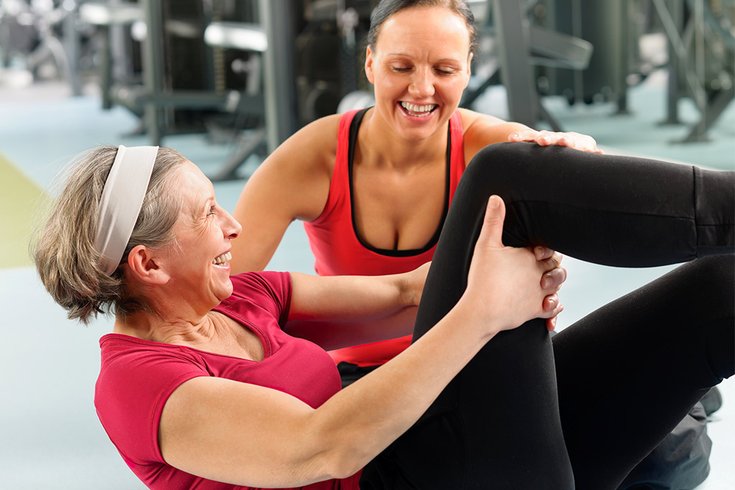
May 30, 2019
 Source/Image licensed by Ingram Image
Source/Image licensed by Ingram Image
Stretching exercises improve the flexibility in the joints and muscles – no matter the age.
Exercise is not just for young and middle-aged adults anymore. More physicians and other health care providers are encouraging adults 50 years and older to take part in cardio, strength and flexibility exercises daily. Why? Because studies are revealing that exercise improves health and wellness in this age group.
Each type of exercise has special benefits for older adults. Mature men and women who practice each one on a regular basis reap the most rewards.
Studies show that strength or resistance exercise may help older adults reduce the risk of falling. Falls are the most common cause of serious injury for older adults, so how does strength training help? As people age, muscle fiber and bone density deteriorate. Strength exercises slow this process down by building muscle fiber and bone density. Sturdy legs and core (abdominals, back and waist) support you whether you are moving or staying still.
Aerobic exercise is just as important as resistance exercise for improving functional capacity for older adults. Aerobic simply means “with oxygen.” Aerobic exercise is generally any exercise that is prolonged and produces a noticeable increase in heart rate and breathing, according to the American College of Sports Medicine. Aerobic activity can be walking, running, swimming, biking, hiking, dancing, etc. Where strength or resistance training improves muscles and bones, aerobic training improves circulation, lung capacity, and heart strength. An added value here for folks looking to lose weight: aerobic activity also burns body fat.
Stretching exercises improve the flexibility in your joints and muscles. Stretching can be static or active, but stretching should be done every day, especially after cardio and strength exercises or after staying in one position for an extended period of time. Stretching brings relief to sore muscles and enhances agility. Stretching is also relaxing and calms your nerves.
Balance exercises can be done every day. Doing this type of activity will reduce your risk of falling and will help you feel more confident walking on uneven surfaces like sand or gravel. You can practice your balance just about anywhere. You may not want to walk along a curb like you did as a kid, but you can walk heel-to-toe on a line or stand on one foot.
Studies also show that daily exercise, regardless of what type, improves our sense of well-being by increasing our endorphin levels. Endorphins are chemicals we naturally have in our brains that provides a sense of satisfaction and contentment.
How much exercise is enough to produce results for people 50+ years old?
According to the American College of Sports Medicine, one of the leading associations in the health and fitness field, it depends on the type of exercise and the condition of the individual. Fitness professionals go by the FITT principle: Frequency, Intensity, Time and Type.
For strength training, a healthy older adult should work on strengthening all major muscles at least two days a week (frequency). Intensity should be between moderate and very challenging, the American College of Sports Medicine says. A strength training routine for one person may take 20 minutes, but for another it may take an hour (time). It depends on how many exercises and body parts you want to include in your workout.
There are many types of strength or resistance exercises. Some people use weights and machines, others use resistance bands or medicine balls. All types are effective for building strength, improving balance, and enhancing or maintaining function. There is no “best way” to build your muscles and bones. Trying out different types of equipment and programs retains your interest and challenges your brain!
For aerobic or cardiovascular activity, adults older than 50 should try to do 30 minutes at least five days a week, or 10 minutes at a time if longer duration is too much, according to the Pennsylvania Department of Aging. Intensity should be such that you feel your heart pounding and that you are breathing faster than usual. All types of cardio exercises are beneficial. It depends on what you like. The more you enjoy the activity, the more likely you will do it regularly.
Getting or staying fit increases your energy, helps burn excess body fat, lowers your risk for heart disease and diabetes, and fights anxiety and depression. Exercising regularly improves your brain function, agility, flexibility, and balance. Exercising your body regularly is probably the best gift you can give to yourself as you age. It truly is the best health insurance!
Jess Lowy is an exercise physiologist for the Healthplex Sports Club in Springfield, Delaware County. For information about the Healthplex Sports Club, visit its website or call 610-328-8888.